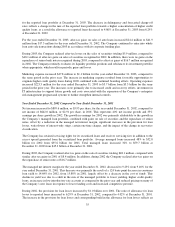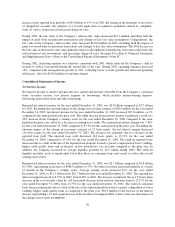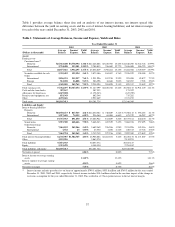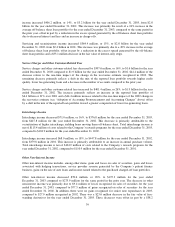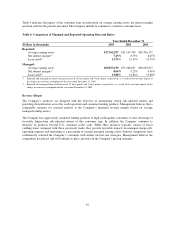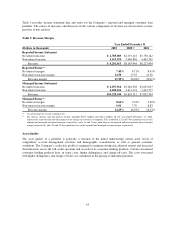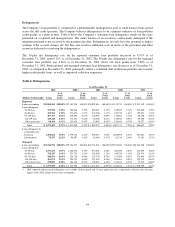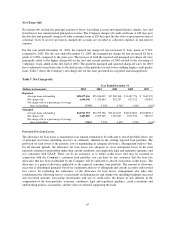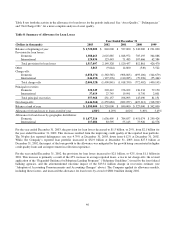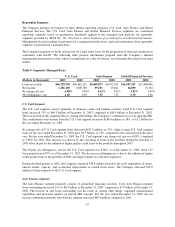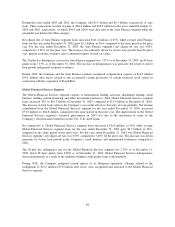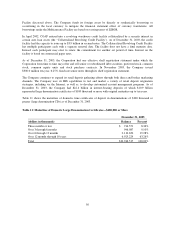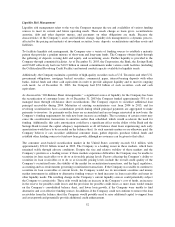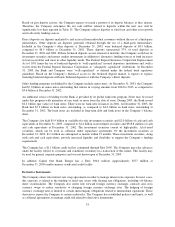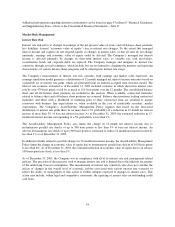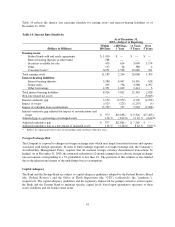Capital One 2003 Annual Report Download - page 63
Download and view the complete annual report
Please find page 63 of the 2003 Capital One annual report below. You can navigate through the pages in the report by either clicking on the pages listed below, or by using the keyword search tool below to find specific information within the annual report.
Net Charge-Offs
Net charge-offs include the principal amount of losses (excluding accrued and unpaid finance charges, fees and
fraud losses) less current period principal recoveries. The Company charges off credit card loans at 180 days past
the due date and generally charges off other consumer loans at 120 days past the due date or upon repossession of
collateral. Costs to recover previously charged-off accounts are recorded as collection expenses in non-interest
expense.
For the year ended December 31, 2003, the reported net charge-off rate increased 71 basis points to 5.74%
compared to 2002. For the year ended December 31, 2003, the managed net charge-off rate increased 62 basis
points to 5.86% compared to the prior year. The increase in both the reported and managed net charge-off rates
principally relate to the higher charge-offs in the first and second quarters of 2003 related to the seasoning of
“subprime” loans added in the first half of 2002. The quarterly managed and reported charge-off rates for 2003
have continued to trend lower due to the shift in mix of the portfolio towards lower yielding, higher credit quality
loans. Table 7 shows the Company’s net charge-offs for the years presented on a reported and managed basis.
Table 7: Net Charge-offs
Year Ended December 31
(Dollars in thousands) 2003 2002 2001 2000 1999
Reported:
Average loans outstanding $28,677,616 $25,036,019 $17,284,306 $11,487,776 $ 7,667,355
Net charge-offs 1,646,360 1,259,684 822,257 627,312 318,992
Net charge-offs as a percentage of average
loans outstanding 5.74% 5.03% 4.76% 5.46% 4.16%
Managed:
Average loans outstanding $62,911,953 $52,799,566 $35,612,617 $22,634,862 $18,046,913
Net charge-offs 3,683,887 2,769,249 1,655,947 1,031,590 782,537
Net charge-offs as a percentage of average
loans outstanding 5.86% 5.24% 4.65% 4.56% 4.34%
Provision For Loan Losses
The allowance for loan losses is maintained at an amount estimated to be sufficient to absorb probable losses, net
of principal recoveries (including recovery of collateral), inherent in the existing reported loan portfolio. The
provision for loan losses is the periodic cost of maintaining an adequate allowance. Management believes that,
for all relevant periods, the allowance for loan losses was adequate to cover anticipated losses in the total
reported consumer loan portfolio under then current conditions, met applicable legal and regulatory guidance and
was consistent with GAAP. There can be no assurance as to future credit losses that may be incurred in
connection with the Company’s consumer loan portfolio, nor can there be any assurance that the loan loss
allowance that has been established by the Company will be sufficient to absorb such future credit losses. The
allowance is a general allowance applicable to the reported consumer loan portfolio. The amount of allowance
necessary is determined primarily based on a migration analysis of delinquent and current accounts and forward
loss curves. In evaluating the sufficiency of the allowance for loan losses, management also takes into
consideration the following factors: recent trends in delinquencies and charge-offs including bankrupt, deceased
and recovered amounts; forecasting uncertainties and size of credit risks; the degree of risk inherent in the
composition of the loan portfolio; economic conditions; legal and regulatory guidance; credit evaluations and
underwriting policies; seasonality; and the value of collateral supporting the loans.
45


